
8 Most Famous London Clocks and the History Behind Them
We love London with all its history and quirky detail and there’s always lots of facts and information to share. In the first of an occasional series of themes and lesser known facts – enjoy!
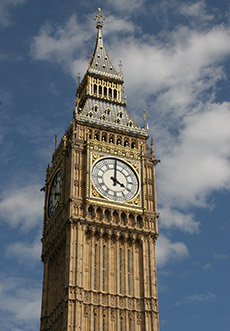
Big Ben, Palace of Westminster
It’s one of London’s most famous landmarks, but ‘Big Ben’ isn’t the name of the clock, it’s the nickname of the bell within the tower. Officially renamed the Elizabeth Tower to celebrate the Queen’s Diamond Jubilee (prior to 2012 it was known as simply the ‘Clock Tower’) it stands 315 feet high (96 meters) and holds the second largest four-faced chiming clock in the world (Minneapolis City Hall has the first). The clock and dials were designed by Augustus Pugin in 1834, and the actual clock movement was designed by lawyer and amateur horologist Edmund Beckett Denison, and George Aiy, the Astronomer Royal. Completed in 185 4, the hour hand is 9 feet (2.7 m) l and the minute hand 14 feet (4.3 m) long. And, in an interesting bit of engineering, a small stack of old penny coins are used to adjust the time of the clock. By adding or removing a penny the clock speed will change by 0.4 seconds per day. One more interesting fact: following the 2003 Jubilee Line excavations, the clock tower tilts slightly to the North West and is now visible to the naked eye – the ‘leaning Tower of Westminster’ could be a future London attraction!
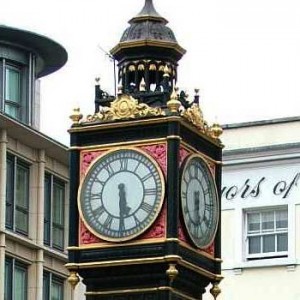
Little Ben
Big Ben’s younger brother is the miniature clock tower by Vauxhall Bridge Road and Victoria Street in Westminster. Erected in 1892, removed in 1964, restored in 1981, the body of the clock includes the rhyming couplet: “My hands you may retard or may advance, my heart beats true for England as for France”. And, the reference to France is because the clock is permanently set to Daylight Saving Time (DST) making the time correct for France during the winter and for the UK during the summer months.
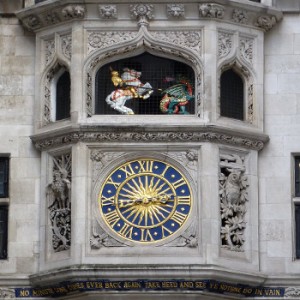
Liberty Clock, Regent’s Street
Liberty’s recently renovated historic timepiece depicts St George majestically slaying the dragon. Every quarter of an hour St George chases the dragon around the clock and on the hour, with every chime, he raises his sword to slay the dragon. Also, each corner of the clock face features four winged heads to represent the four winds, and below the clock is the significant inscription: “No minute gone comes back again, Take heed and see yea nothing do in vain”.
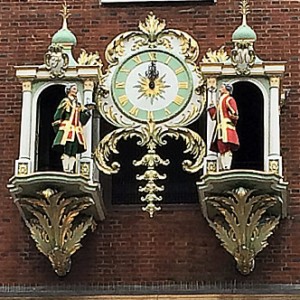
Fortnum & Mason, Piccadilly
In 1965 Fortnum and Mason added an ornate clock to the front of their retail emporium on Piccadilly. The clock weighed three tons and when installed the front of the building had to be reinforced. The 18 bells inside the clock were made at Whitechapel Bell Foundry, where the Big Ben and the original Liberty bell were created, and chime every fifteen minutes. On the hour when the bells chime the doors open and the figures of Mr Fortnum and Mr Mason appear, bow at each other, and return inside.
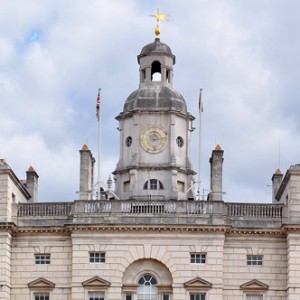
Horse Guard’s Clock Tower, Whitehall
Built in the 18th century by William Kent and John Vardy, Horse Guards Parade has long been a popular tourist attraction in London. The original clock failed in 1768 and its replacement was the most accurate clock in London, until Big Ben came along. Manufactured by Thwaites & Reed, the clock face includes a black mark at 2 o’clock to indicate the time that King Charles I was executed in January 1649.
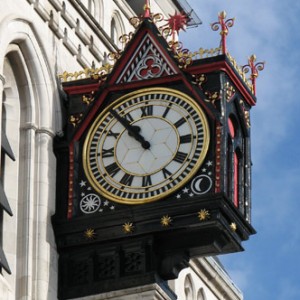
Royal Courts of Justice, Fleet Street
High above Fleet Street sits the Royal Courts of Justice clock. Known for the fictional tale of Sweeney Todd (The Demon Barber), the clock is one of the only eight ‘Janus’ (double face) clocks in Europe.
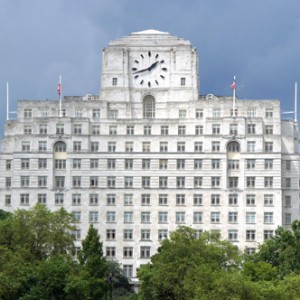
Shell Mex House, The Strand
The Shell Mex House is the biggest clock face in London and was known for a time as ‘Big Benzene’. The building at number 80 on the Strand has the clock facing outwards onto the Thames and towards the Strand. In a former life the building was the first official headquarters of the Royal Air Force and nowadays is used as office space by companies owned by Pearson PLC.
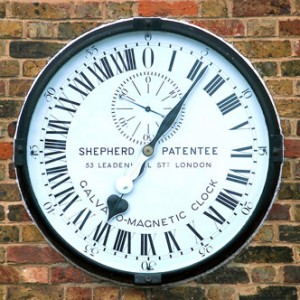
Shepherd Gate Clock, Greenwich
The Shepherd Gate Clock is the official name for the clock mounted outside the gate of the Royal Observatory. Built in 1852 by Charles Shepherd, the design uses a 24-hour analogue dial and it was the first clock to publicly display Greenwich Mean Time (GMT). The Royal Observatory at Greenwich has another famous and timely presence: it’s where you can stand on the Meridian line with one foot in the Eastern and the other in Western hemisphere.
This website uses cookies so that we can provide you with the best user experience possible. Cookie information is stored in your browser and performs functions such as recognising you when you return to our website and helping our team to understand which sections of the website you find most interesting and useful.
Strictly Necessary Cookie should be enabled at all times so that we can save your preferences for cookie settings.
If you disable this cookie, we will not be able to save your preferences. This means that every time you visit this website you will need to enable or disable cookies again.
This website uses Google Analytics to collect anonymous information such as the number of visitors to the site, and the most popular pages.
Keeping this cookie enabled helps us to improve our website.
Please enable Strictly Necessary Cookies first so that we can save your preferences!

